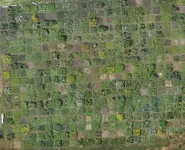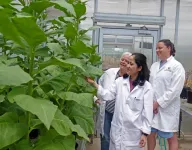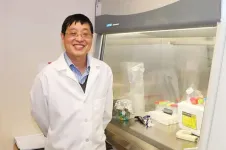(Press-News.org) Remote sensing technology has become a vital tool for scientists over the past several decades for monitoring changes in land use, ice cover, and vegetation across the globe. Satellite imagery, however, is typically available at only coarse resolutions, allowing only for the analysis of broad trends over large areas. Remote-controlled drones are an increasingly affordable alternative for researchers working at finer scales in ecology and agriculture, but the laser-based technology used to estimate plant productivity and biomass, such as light detection and ranging (LiDAR), remain prohibitively expensive.
In research presented in a recently published issue of Applications in Plant Sciences, researchers used low-cost remote sensing technology to produce multispectral vegetation indices and 3D photomosaics of the vegetation in a tallgrass prairie, comparing aerial estimates of biomass with direct measurements taken in the field. Based on their results, photogrammetry is a reliable way to estimate biomass, landcover, and ecosystem productivity, with several potential cost-saving implications for conservation and agricultural science.
Researchers carried out remote sensing data collection on a tallgrass prairie restoration experiment at the Morton Arboretum in Lisle, Illinois.
"The restoration experiment is designed to determine whether or not phylogenetic diversity and functional diversity affect restoration outcomes," said senior author Andrew Hipp, the Plant Systematist and Herbarium Director at the Morton Arboretum.
To accomplish this goal, Hipp and his research team drew from a total of 127 prairie species, each of which was planted as a monoculture in 4 m2 plots. These species were also mixed in various combinations in multispecies plots of the same size, ranging from high, medium, and low phylogenetic diversity crossed with high and low trait diversity.
Lead author Lane Scher, a community ecologist at Duke University, saw the experiment's design as a unique opportunity to test the precision of photogrammetry-based estimates of biomass between monocultures and multispecies plots.
The researchers used a DJI Phantom 4 drone equipped with a standard camera as well as a multispectral sensor that would allow them to calculate various vegetation indices -- metrics based on ratios of light wavelengths that indicate the relative health and productivity of plant ecosystems.
By stitching together close to 600 overlapping images, the researchers created a set of mosaics of the study site, allowing them to calculate the height of the vegetation in each plot. By extrapolation, they were then able to estimate the total biomass of the tallgrass species.
Analytical comparisons made between the aerial- and field-based measurements indicate that estimates of biomass derived from photogrammetry explained up to 47% of the variation in biomass for multispecies plots, a fairly significant result that shows promise for this method.
"Of the metrics we used, volume was the best predictor of productivity, which is great news, because it's also the least expensive to measure," said Scher. Although the researchers used a multispectral sensor to obtain imagery for different wavelengths of light to calculate vegetation indices, their results suggest that a simple RGB camera is all that's needed to reliably estimate biomass.
These methods might not be as applicable to monocultures, however. The explanatory power of their model, which accounted for 47% of the variation in multispecies plots, dropped to 34% in monocultures, a trend that wasn't entirely unexpected by the team.
"In monocultures, you typically have only one layer of vegetation," said Scher. Plants of the same species and variety typically have the same growth form, with the result that most of the leaves compete for space in a single, crowded layer.
"In multispecies plots, however, vegetation can be more evenly spaced vertically," said Scher. Since 3D photogrammetry calculates volume as everything between the soil surface and the top layer of vegetation, plots with plants evenly distributed in height will likely give the most accurate estimates.
While future comparisons with similar LiDAR measurements will be useful in further constraining the accuracy of photogrammetry for the estimation of biomass, the present study outlines a simple, fast, and affordable method to reliably assess vegetation productivity at fine-scale resolutions across large study areas.
INFORMATION:
Scher, C. L., N. Karimi, M.-C. Glasenhardt, A. Tuffin, C. H. Cannon, B. C. Scharenbroch, and A. L. Hipp. 2020. Application of remote sensing technology to estimate productivity and assess phylogenetic heritability. Applications in Plant Sciences 8(11): e11401. https://doi.org/10.1002/aps3.11401
New research has shown that results of blood tests routinely performed by GPs everywhere contain a hidden fingerprint that can identify people silently developing potentially fatal liver cirrhosis.
The researchers have developed an algorithm to detect this fingerprint that could be freely installed on any clinical computer, making this a low-cost way for GPs to carry out large scale screening using patient data they already hold.
Liver cirrhosis is the second leading disease causing premature death in working-age people (after heart disease). It develops silently ...
Peer-reviewed / Observational study / People
For the study, published in the journal Diabetes, Obesity and Metabolism, researchers analysed data from the UK Biobank of 500,000 people aged 58 years on average, and found that people with higher than normal blood sugar levels were 42% more likely to experience cognitive decline over an average of four years, and were 54% more likely to develop vascular dementia over an average of eight years (although absolute rates of both cognitive decline and dementia were low).
The associations remained true after other influential factors had been taken into account - including age, deprivation, smoking, BMI and whether or not participants had cardiovascular disease.
People with ...
A team of scientists have measured the relative importance of the different obstacles that carbon dioxide (CO2) encounters in its voyage from the atmosphere to the interior of plant cells, where it is converted into sugars. This research leading method provides much needed information that will help to increase the yield of important food crops such as cowpea, soybean and cassava.
"Our data highlights promising targets to improve the diffusion of CO2 through the leaf with the aim of boosting crop productivity," says lead author Dr Tory Clarke, who works at The Australian National University (ANU), as part of the Realizing Increased Photosynthetic ...
Psychologists at the University of Bath, Cardiff, and London have developed the first ever 'mind-reading questionnaire' to assess how well people understand what others are really thinking.
A new approach to 'mind-reading' has been developed by researchers at the University of Bath, Cardiff, and London to improve how well we understand what others are thinking. And it transpires that women are much better than men at putting themselves in someone else's shoes.
Mind-reading, sometimes referred to in psychology as 'mentalising', is an important ability enabling us to pick-up on subtle behavioural cues that might indicate that someone we are speaking to is thinking ...
A new modelling study published in Anaesthesia (a journal of the Association of Anaesthetists) shows that the UK's coronavirus vaccination program is already reducing daily deaths. However, reductions of hospital and intensive care (ICU) admissions will likely take several weeks longer, with large reductions seen by the end of March and continuing into April.
The study is by Professor Tim Cook (Consultant in Anaesthesia and Intensive Care Medicine, Royal United Hospitals Bath NHS Foundation Trust, Bath, UK, and Honorary Professor, School of Medicine, University of Bristol, UK) and Mr ...
Anti-retroviral drugs are a vital tool in the prevention and treatment of HIV. A new study of pregnant women in Tanzania shows that life-long antiviral treatment also seems to prevent viral transmission from mother to baby. The results of the study, which was conducted in part by researchers at Karolinska Institutet in Sweden and published in Lancet HIV, make a promising contribution to the WHO's work with HIV prevention in low and middle-income countries.
Just over eight years ago, the World Health Organisation (WHO) issued recommendations known as Option B+ for a simpler and more effective prevention and treatment for HIV during and beyond pregnancy in low and middle-income countries.
One arm of the Option B+ programme involved ensuring that pregnant women with HIV ...
Researchers from North Carolina State University used a three-model approach to trace the between-farm spread of porcine epidemic diarrhea virus (PEDV), as well as to analyze the efficacy of different control strategies in these scenarios. The approach may enable farmers to be more proactive in preventing the spread of PEDV and to optimize their efforts to control the disease.
PEDV is a virus that causes high mortality rates in preweaned piglets. The virus emerged in the U.S. in 2013 and by 2014 had infected approximately 50 percent of breeding herds. PEDV is transmitted by contact with contaminated fecal matter.
"We wanted to compare three different models by using actual outbreak data in order to test their efficacy," says Gustavo Machado, assistant professor of population ...
To build a universal quantum computer from fragile quantum components, effective implementation of quantum error correction (QEC) is an essential requirement and a central challenge. QEC is used in quantum computing, which has the potential to solve scientific problems beyond the scope of supercomputers, to protect quantum information from errors due to various noise.
Published by the journal Nature, research co-authored by University of Massachusetts Amherst physicist Chen Wang, graduate students Jeffrey Gertler and Shruti Shirol, and postdoctoral researcher Juliang Li takes a step toward building a fault-tolerant ...
New research from the Indiana University Kelley School of Business shows first evidence that watching and learning from others can help reduce bias and improve decision-making.
The research, published END ...
MUSC Hollings Cancer Center researcher Yongxia Wu, Ph.D., identified a new target molecule in the fight against graft-versus-host disease (GVHD). Bone marrow transplant, a treatment for certain blood cancers, is accompanied by potentially life-threatening GVHD in nearly 50% of patients. A January 2021 paper published in Cellular and Molecular Immunology revealed that activating a molecule called STING may be a new approach to reduce GVHD.
Xue-Zhong Yu, M.D., professor in the Department of Microbiology and Immunology, focuses on understanding the intricate immune mechanisms that regulate GVHD development and anti-tumor activity.
Recently, STING (stimulator of interferon genes) has been highly studied in the context of cancer. Data from other groups has shown that STING activation ...





